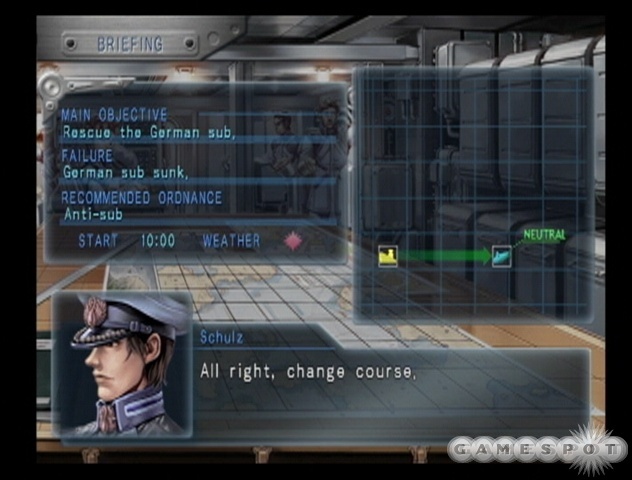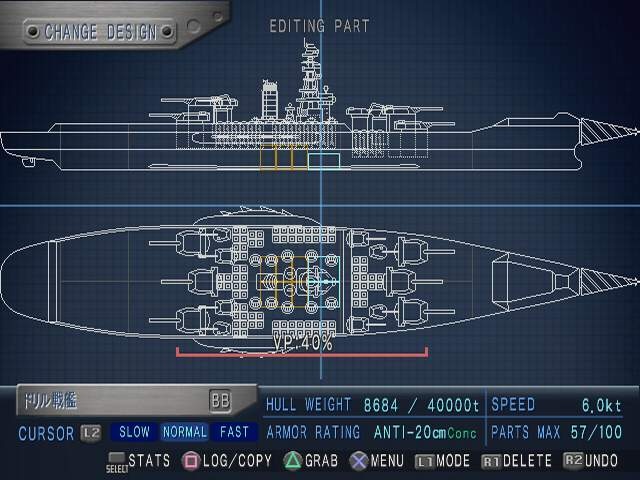It's not that much of an improvement over 2003's Naval Ops: Warship Gunner, but the fundamental formula of researching, building, and taking a naval warship into battle still retains some basic appeal in Warship Gunner 2. This isn't a game for everyone--the presentation looks downright antique, the ship controls can be arcane, and there's ultimately a fairly limited appeal to step-by-step ship-building. It's not particularly kind to newcomers, but those who enjoyed Naval Ops: Warship Gunner will appreciate the huge quantity of new missions, and those who can wade through the game's faults will find a PS2 game with few equals.

Through a series of set paintings, character portraits, and a novella's worth of scrolling text, Warship Gunner tells a tale of civil war in the country of Wilkia. As a captain fresh out of "the academy," you are unwittingly thrust into the middle of what quickly escalates into global conflict with several different factions and shifting alliances. Indicative of the overall tone in Warship Gunner 2, the story is often impenetrable and bone-dry, though it ultimately serves its purpose of setting up each upcoming mission.
Warship Gunner 2 breaks down into three easy pieces. The combat missions put you in direct control of a ship as you take on enemy forces that attack from land, sea, and air; protect allied forces; and simply try to make it through the day without sinking. The controls can take quite a bit of getting used to. Basic controls map speed and direction control to the D pad, while the left analog stick controls your selected weapon. The triangle and X buttons let you scroll through the weapons that you've equipped your ship with, while the circle button fires the selected weapon. Ship controls and weapon aiming operate independently, making it easy to run circles around enemies as you pummel them from afar. There are lots of other little nuances, such as the way you can lock-on to your targets at the sacrifice of directional control, or the different kinds of repairs you can make when in the midst of the action. The heads-up display overlay on your screen is thick with somewhat cryptic information about your ship and your surroundings, and things become even more obfuscated when you take command of a submarine. It's an intimidating game to just leap right into, which makes the extremely granular tutorials indispensable, if a bit tedious.
You start off with a pretty run-of-the-mill destroyer, but with each successful mission comes money that can be used for research and development. The R&D tech tree isn't much to look at, but it offers a downright boggling number of ship-building options. There's a small universe of cannons, machine guns, torpedoes, rockets, depth charges, and as you continue to expand your research, you eventually gain access to insane futuristic weapon technologies. On top of all that, there are hulls and propulsion systems to choose from, as well as more specialized equipment like illuminating flares and night vision.
The R&D system dovetails nicely into the game's ship-building mode, which is in some ways more engaging than the actual combat. Choosing from the technology that you've gained access to through R&D, you can custom-build a ship almost entirely from scratch, and every single part you add has an effect on your ship's performance. Using a wire-frame model of your ship-in-progress, you can choose very specific placement for just about every component, and it all makes pretty logical sense. Adding heavier armor to your hull will make it more impervious to enemy attacks, but it'll also weigh more, which will lower your acceleration and top speed. Or, you can choose to cover the decks with massive cannons that can completely decimate any surface targets, but you'll be much more vulnerable to aerial or submarine attacks. If choosing smokestack locations and the height and orientation of your aft cannons doesn't sound interesting, you can hit the seas in many different prebuilt ships--though if naval minutiae aren't appealing, you're probably looking at the wrong game.
Once you've learned to cope with the game's proprietary interface, you quickly settle into a somewhat monotonous routine of taking on missions, using the spoils of war to research new technology, applying your latest and greatest technology to your ship, and then heading back out into the water. The combat plays with a light blend of tactical ship placement and targeting your enemies on the fly, and there's definitely something engaging and satisfying about the methodical pace.

The presentation definitely doesn't do much to make the game more palatable, with graphics that often look downright rustic. The bland palette of gray ships on blue waters gets old quickly, and though the ships look realistic enough, the way they turn from the center makes them look more like toy boats. There are functional problems as well--portions of your hub can be utterly indistinguishable from the background at times, and it can be difficult to tell when your targeting reticule is actually hovering over a target. The game doesn't sound much better either, with a generic, MIDI-synthesized military soundtrack, a handful of voice clips that get repeated ad nauseum, and some muddled weapon fire.
With its bizarre alternate-reality plot, dated, low-budget presentation, and a general fixation on naval warfare, most people will find Warship Gunner 2 pretty unapproachable. However, considering the lean selection of simulations of any kind on the PlayStation 2, those with an appreciation for naval warfare will likely find the game's compromising elements worth adapting to, especially if they find the idea of constructing their own warship appealing.